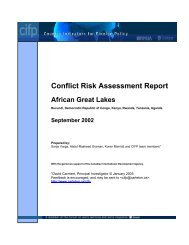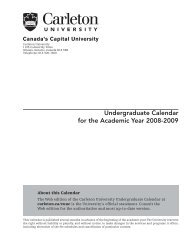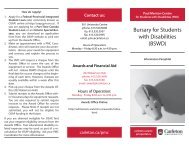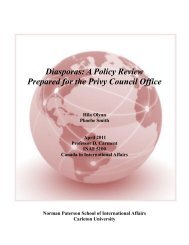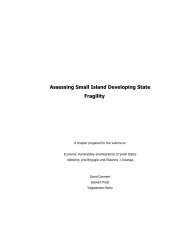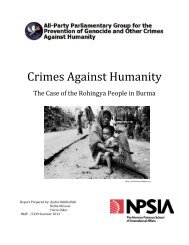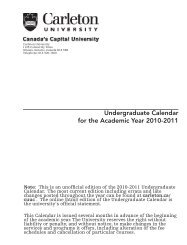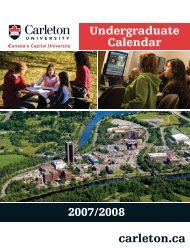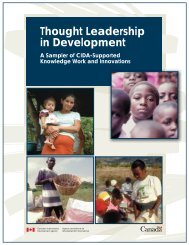Uyghurs at Risk Briefing Note - Www3.carleton.ca - Carleton University
Uyghurs at Risk Briefing Note - Www3.carleton.ca - Carleton University
Uyghurs at Risk Briefing Note - Www3.carleton.ca - Carleton University
You also want an ePaper? Increase the reach of your titles
YUMPU automatically turns print PDFs into web optimized ePapers that Google loves.
THE NORMAN PATERSON SCHOOL OF INTERNATIONAL AFFAIRS<br />
CARLETON UNIVERSITY<br />
The Situ<strong>at</strong>ion of the Uighurs in China<br />
(Source: David Gray/Reuters)<br />
M<strong>at</strong>hieu Bélanger<br />
Jason D’Amour<br />
Jordan Ray<br />
Professor David Carment<br />
INAF 5439 Ethnic Conflict<br />
June 13, 2013
I. Executive Summary<br />
The Uighurs in China remain under thre<strong>at</strong> of assimil<strong>at</strong>ion, repression and discrimin<strong>at</strong>ion, slowly becoming<br />
marginalised in their indigenous home. Conflict has been ongoing since 1991, with sporadi<strong>ca</strong>lly occurring<br />
violence and ethnic riots. On April 24, 2013, 21 people were killed in Kashgar; July 2009 saw riots in<br />
Urumqi, with 197 dead and 1700 injured; and executions followed an incident in Ghulja in 1997. The<br />
Uighurs are faced with growing politi<strong>ca</strong>l and economic inequalities and denial of services, particularly in<br />
educ<strong>at</strong>ion and culture. The risk of continuing instability remains high, with efforts towards regional<br />
development fuelling increased in-migr<strong>at</strong>ion, and repression tactics by the Chinese government indic<strong>at</strong>e the<br />
occurrence of Crimes against Humanity. Recommend<strong>at</strong>ions to concerned parties are to increase lobbying<br />
efforts, and to make human rights issues a central policy focus, as well as to encourage awareness through<br />
research.<br />
II. Conflict Background: the Uighurs in China<br />
N<strong>at</strong>ion building has succeeded in the People’s Republic of China’s (“China”) core provinces, often <strong>ca</strong>lled<br />
China proper. The Hans comprise 90% of the popul<strong>at</strong>ion believe in and support the idea of the Chinese<br />
n<strong>at</strong>ion. Resistance to incorpor<strong>at</strong>ion into th<strong>at</strong> n<strong>at</strong>ion, and to the very idea of n<strong>at</strong>ion, is most visible in Xinjiang,<br />
where the Hans do not constitute the majority. In this region, covering one sixth of the total area of China,<br />
but holding only about 1% the total popul<strong>at</strong>ion i , the Uighur People are the majority.<br />
The Uighur People are a Turkic ethnic group indigenous to Eastern Central Asia, and the largest part of the<br />
popul<strong>at</strong>ion is situ<strong>at</strong>ed in the Xinjiang Uighur Autonomous Region (XUAR) in the Northwestern part of<br />
China. ii They are of Sunni Muslim faith, and they speak their own Turkic language, <strong>ca</strong>lled Uighur. Uighurs<br />
are predominant in the Tarim Basin oases in the south of the region. In 2007, there were 9.65 million Uighurs<br />
in the XUAR. Even though Uighurs are still techni<strong>ca</strong>lly the majority in the region, they now constitute only a<br />
plurality. Indeed, through government policies, the popul<strong>at</strong>ion of Hans in the XUAR went from a tiny<br />
minority in the 1940s to roughly 8.2 million in 2007.<br />
According to the Minorities <strong>at</strong> <strong>Risk</strong> Project, the primary grievances of Turkmen in China, of which Uighurs<br />
constitute the majority, are politi<strong>ca</strong>l in n<strong>at</strong>ure. iii There are no legitim<strong>at</strong>e politi<strong>ca</strong>l parties aside from the<br />
Chinese Communist Party (CCP) th<strong>at</strong> they may join (other smaller parties are not even considered to be<br />
opposition). iv And even if a Uighur must head the Xinjiang Uighur autonomous regional government under<br />
the Regional Ethnic Autonomy Laws (1984) v , the st<strong>at</strong>e also maintains th<strong>at</strong> such leaders are able and expected<br />
to represent the common interest of all citizens. Therefore, leaders who focus on the interests of their group<br />
have frequently been condemned as narrow n<strong>at</strong>ionalists by the party-st<strong>at</strong>e and removed from their offices. vi<br />
Another major area of concerns is the territory itself. Even though the region of Xinjiang remains remote in<br />
the popular imagin<strong>at</strong>ion of Chinese, several of the region’s fe<strong>at</strong>ures make it integral to China in the eyes of<br />
the leadership in Beijing. vii There are rich reserves of n<strong>at</strong>ural gas and oil, potentially up to one third of<br />
country’s total production <strong>ca</strong>pacity. It is predicted th<strong>at</strong> the XUAR will become the number-one coal<br />
producing region in China by 2020 as it strives to meet its energy needs for development, and is already a<br />
major contributor to China’s energy needs, holding approxim<strong>at</strong>ely 38% and 25% of the n<strong>at</strong>ional coal and<br />
n<strong>at</strong>ural gas reserves respectively. viii There are also large quantities of gold, nonferrous metals, as well as<br />
uranium. ix Finally, some have argued th<strong>at</strong> the size of the land could be a potential solution to overcrowding in<br />
China’s heartland. Migr<strong>at</strong>ions of Hans Chinese in the XUAR since the 1940s could be partly explained by<br />
this factor. x<br />
1
Finally, in terms of educ<strong>at</strong>ion and religious practice, important Chinese documents give rights on paper to the<br />
Uighurs. xi Article 4 of the Chinese Constitution st<strong>at</strong>es th<strong>at</strong>, “All ethnic groups have the freedom to use and<br />
develop their own spoken and written languages.” xii Also, article 36 of the China's Regional Ethnic<br />
Autonomy Law establishes the principle th<strong>at</strong> language policy should be decided <strong>at</strong> the lo<strong>ca</strong>l level. Indeed,<br />
“Schools and other educ<strong>at</strong>ional organiz<strong>at</strong>ions recruiting mostly ethnic minority students should, whenever<br />
possible, use textbooks in their own languages and use these languages as the media of instructions.” xiii<br />
Finally, China's Constitution of 1982 stipul<strong>at</strong>es th<strong>at</strong> all citizens may enjoy freedom of religious belief under<br />
Article 36. xiv However, various events and doings th<strong>at</strong> will be discussed in this report seem to limit those<br />
guaranteed rights for the Uighurs.<br />
III. Causes, Implic<strong>at</strong>ions<br />
A. Geography and Territory<br />
The conflict is <strong>ca</strong>used in part by territorial competition. xv Histori<strong>ca</strong>l narr<strong>at</strong>ives place the territory of Xinjiang<br />
within either a legacy of Chinese ownership, or within a histori<strong>ca</strong>l Uighur homeland. The Chinese<br />
government has long argued th<strong>at</strong> Xinjiang has been controlled by the central government for hundreds of<br />
years, while the Uighurs <strong>ca</strong>n clearly identify two periods during the 1930s and 1940s, when they maintained<br />
independent republics. xvi Thus, the Chinese have constructed an image of an indivisible territory, upon<br />
which Chinese sovereignty rests. On the contrary, the Uighurs view the territory of Xinjiang as their<br />
homeland, and this <strong>ca</strong>n be necessary for their survival. The territory has str<strong>at</strong>egic worth however, bordering<br />
the Central Asian Republics, and containing large quantities of mineral resources.<br />
B. Inequalities<br />
Consequently, resources play a signifi<strong>ca</strong>nt role in the conflict, as the Uighurs are unable to particip<strong>at</strong>e equally<br />
in the competition for resources. The situ<strong>at</strong>ion in Xinjiang demonstr<strong>at</strong>es an instance where cultural<br />
differences coincide with, and are reinforced by socio-economic and politi<strong>ca</strong>l differences. xvii Due to their<br />
st<strong>at</strong>us as an autonomous minority within China, the Uighurs are able to maintain limited politi<strong>ca</strong>l inclusion.<br />
As st<strong>at</strong>ed earlier, though there must be a Uighur <strong>at</strong> the head of the regional government, the leadership must<br />
remain loyal to the Chinese st<strong>at</strong>e, and lo<strong>ca</strong>l parties are unable to be represented in government, as the<br />
Communist Party maintains a monopoly. However, there are clear economic and social grievances th<strong>at</strong> leave<br />
the Uighurs disadvantaged. Economic particip<strong>at</strong>ion is constrained, and assimil<strong>at</strong>ionist policies have diluted<br />
the popul<strong>at</strong>ion demographics, in addition to cre<strong>at</strong>ing difficulties for the Uighur to publicly practice either<br />
their religious or cultural values.<br />
C. Religion<br />
A question th<strong>at</strong> must be raised however, is how superficial is culture in rel<strong>at</strong>ion to other factors? Islam is <strong>at</strong><br />
the heart of Uighur identity, and thus relinquishing their rights to Fasting and Prayer seems counterintuitive.<br />
Religion may not be the primary factor th<strong>at</strong> motiv<strong>at</strong>es violence, as inequalities and territorial represent<strong>at</strong>ions<br />
may speak to a larger audience. However, even if religious identities are not necessarily salient, any form of<br />
discrimin<strong>at</strong>ion against Islamic values has the potential to produce extreme salience. xviii<br />
D. Rel<strong>at</strong>ive Depriv<strong>at</strong>ion<br />
Xinjiang thus makes a good <strong>ca</strong>se for a more instrumentalist argument. The establishment of the XUAR and<br />
the structures established by the dominant Han Chinese group <strong>ca</strong>n be interpreted to have led to a contention<br />
of power, and a separ<strong>at</strong>ion along ‘civiliz<strong>at</strong>ional fault lines.’ The existence of the Uighur region contributes to<br />
2
a perpetu<strong>at</strong>ion of a cultural distinction, and the increasing levels of competition and inequality have led to a<br />
gre<strong>at</strong>er salience of ethnic identity. xix Consequently, the Uighurs are beginning to understand th<strong>at</strong> they are<br />
limited from engagement in the politi<strong>ca</strong>l, social and economic processes within a region th<strong>at</strong> bears their<br />
name.<br />
E. Regional Implic<strong>at</strong>ions<br />
The Central Asian Republics host a Uighur Diaspora group th<strong>at</strong> be<strong>ca</strong>me vo<strong>ca</strong>l concerning Uighur sovereignty<br />
following the collapse of the Soviet Union. This has complic<strong>at</strong>ed rel<strong>at</strong>ionships with China, and has led to<br />
Chinese pressures on the Central Asian Republics, primarily Kazakhstan and Kyrgyzstan, to ‘muffle’ the<br />
Uighur voices. xx The st<strong>at</strong>es of Central Asia have generally obliged, as China is an increasingly important<br />
trading and security partner, particularly in the involvement of regional actors in the security-oriented<br />
Shanghai Cooper<strong>at</strong>ion Organis<strong>at</strong>ion, and the increasing fears of terrorism and radi<strong>ca</strong>lis<strong>at</strong>ion from Uighurs in<br />
Afghanistan and Pakistan. However, it must be noted, th<strong>at</strong> the triggers for a regional spillover exist, and may<br />
become active in the event of large-s<strong>ca</strong>le violence in the XUAR. The role of Turkey must also be<br />
considered, as Turkish Prime Minister Recep Tayyip Erdoğan described the violence in 2009 as “genocide,”<br />
and has vo<strong>ca</strong>lised Turkish concerns with the Chinese. xxi<br />
IV. <strong>Risk</strong> Assessment<br />
The Uighur face the thre<strong>at</strong> of having their culture, language, and religion slowly disappear under st<strong>at</strong>esponsored<br />
policies of assimil<strong>at</strong>ion and repression. As one scholar noted, it is becoming increasingly easy for<br />
Uighurs in Xinjiang to become “sinified,” or inducted into the ethnic Han Chinese popul<strong>at</strong>ion, and<br />
increasingly difficult to resist this assimil<strong>at</strong>ion. xxii The region’s social, cultural and economic policies have<br />
the dual aims of developing the region for Han Chinese and promoting the assimil<strong>at</strong>ion of ethnic Uighur.<br />
Combined with a military force in the region th<strong>at</strong> numbers 220,000 troops to quell any unrest th<strong>at</strong> may<br />
surface in the region - peaceful or otherwise - Uighurs are faced with the slow erosion of their ethnicity<br />
without any recourse for resistance. xxiii<br />
The Minorities <strong>at</strong> <strong>Risk</strong> project notes th<strong>at</strong> the probability of rebellion continuing is quite high, given the<br />
territorial concentr<strong>at</strong>ion of the Uighur, the various militant politi<strong>ca</strong>l organiz<strong>at</strong>ions dedic<strong>at</strong>ed to continued<br />
resistance, and the continued government repression of the region. xxiv Simultaneously, Minorities <strong>at</strong> <strong>Risk</strong><br />
outlines how the rebellion is stifled by the high level of support for the government by Han Chinese both<br />
within Xinjiang and across the rest of the country. This is in addition to both the difficulties th<strong>at</strong> Uighurs face<br />
in crossing the n<strong>at</strong>ional border to supporting the rebellion from abroad and the continued governmental<br />
efforts <strong>at</strong> economic development, xxv which brings increased migr<strong>at</strong>ion of Han Chinese to the region and<br />
cre<strong>at</strong>es an additional incentive for Uighur to induct themselves into the Han majority.<br />
As has already been noted, there has been a desire for a Uighur-led separ<strong>at</strong>ion of Xinjiang since the shortlived<br />
success of East Turkestan in the 1930s and 1940s. xxvi China on the other hand claims histori<strong>ca</strong>l<br />
dominion over all territory th<strong>at</strong> belonged to the Qing dynasty (1644—1912), which includes Xinjiang. xxvii<br />
This plays into part of an important source of legitimacy for the Chinese Communist Party (CCP): Chinese<br />
n<strong>at</strong>ionalism. Greve notes how quickly the CCP will fall back on n<strong>at</strong>ionalism to bolster its legitimacy, and<br />
how effective the rhetoric invoking the thre<strong>at</strong> of Uighur “separ<strong>at</strong>ists” has been in justifying draconian action<br />
towards the ethnic minority. xxviii In terms of government priorities, China now places stability in Xinjiang on<br />
the same level as achieving sovereignty over Taiwan. xxix<br />
The increasing economic development of Xinjiang, which has increased since Zhang Chunxian replaced<br />
Wang Lequan as Secretary of the Xinjiang branch of the CCP, has many impacts. xxx The development <strong>ca</strong>uses<br />
3
increased migr<strong>at</strong>ion of Han Chinese to the region, xxxi which further dilutes Uighur popul<strong>at</strong>ion, exacerb<strong>at</strong>es<br />
ethnic tension between the Uighur and Han, xxxii increases the incentive for the CCP to maintain stability in<br />
the face of thre<strong>at</strong>s, xxxiii and produces economic benefits th<strong>at</strong> are not equally enjoyed by residents of<br />
Xinjiang. xxxiv<br />
Economic development and internal migr<strong>at</strong>ion is not the only way in which the Chinese government looks to<br />
stabilize Xinjiang, however. The CCP also employs a range of social and cultural policies th<strong>at</strong> amount to<br />
wh<strong>at</strong> one scholar <strong>ca</strong>lls “coercive assimil<strong>at</strong>ion.” In terms of educ<strong>at</strong>ion, teaching the Uighur language has been<br />
phased out in elementary schools and kindergartens, while simultaneously, “Children <strong>at</strong>tending the five-daysper-week<br />
‘boarding’ day-<strong>ca</strong>re establishments may never fully master their parents’ n<strong>at</strong>ive languages.” xxxv As<br />
alluded to earlier, any economic or educ<strong>at</strong>ion opportunity th<strong>at</strong> Uighur children wish to take advantage of<br />
comes <strong>at</strong> the cost of abandoning their ethnic identity, with bright students becoming educ<strong>at</strong>ed far from home<br />
in eastern universities, putting pressure on intergener<strong>at</strong>ional ethnic ties. xxxvi<br />
The tre<strong>at</strong>ment of the Uighur’s Muslim faith is perhaps the most troubling. In an effort to comb<strong>at</strong> one of the<br />
motiv<strong>at</strong>ions of Uighur separ<strong>at</strong>ism, the practice of Islam is heavily restricted. Parents are forbidden from<br />
teaching their religion to their children. Eighteen is the minimum age to enter mosques in the region, which<br />
are surrounded by armed guards. Fasting during Ramadan is prohibited for students, government employees<br />
and almost all others. xxxvii And again, this is all overwhelmingly supported by Han Chinese, who views this<br />
not only as a n<strong>at</strong>ionalistic and security issue, but also as a project of civilizing wh<strong>at</strong> is seen as a backward<br />
race. In an anecdote, Cliff writes,<br />
A Xinjiang-born Han businessman rel<strong>at</strong>ed to me the story of “a little Uighur girl whose role was to<br />
pick up a brick and smash the skulls of Han people lying be<strong>at</strong>en on the ground—to make sure th<strong>at</strong><br />
their brains were spl<strong>at</strong>tered.” He continues, his voice breaking with anger and disgust, “Wh<strong>at</strong> do you<br />
say? A little 13-year-old girl! This whole ethnicity is animal! They’re animals.” Stories of children<br />
involved as both perpetr<strong>at</strong>ors and victims of violence were deployed by all sides, but all of the stories<br />
remain unconfirmed. xxxviii<br />
Given the increasing incentives for the CCP to continue its present policy direction and the assimil<strong>at</strong>ing<br />
impact th<strong>at</strong> these policies have on ethnic Uyghur, there continues to be a high risk of genocide and crimes<br />
against humanity against the Uighur in Xinjiang. Genocide and crimes against humanity in this <strong>ca</strong>se is as<br />
defined under Section 2 of the constitution of the All-Party Parliamentary for the Prevention of Genocide and<br />
Other Crimes Against Humanity. The parts of the definition for genocide th<strong>at</strong> apply are sections 2.1.b and<br />
2.1.c: the <strong>ca</strong>using of serious mental harm to members of the group and deliber<strong>at</strong>ely inflicting conditions of<br />
life <strong>ca</strong>lcul<strong>at</strong>ed to bring about its physi<strong>ca</strong>l destruction in whole or in part.<br />
In terms of crimes against humanity, the CCP appears to be engaging in acts th<strong>at</strong> fall under sections 2.2.e,<br />
2.2.h, and 2.2.k of the aforementioned constitution: severe depriv<strong>at</strong>ion of physi<strong>ca</strong>l, persecution against any<br />
identifiable on ethnic, cultural, religious, or other grounds th<strong>at</strong> or other inhumane acts intentionally <strong>ca</strong>using<br />
gre<strong>at</strong> suffering, or serious injury to body or to mental or physi<strong>ca</strong>l health. xxxix<br />
V. Implic<strong>at</strong>ions for Canada<br />
In the past, Canada spoke up against human rights viol<strong>at</strong>ion in China, notably in the region of Tibet. During<br />
his most recent trip to Canada, Prime Minister Stephen Harper mentioned th<strong>at</strong> “Canada would always be ‘a<br />
vo<strong>ca</strong>l advoc<strong>at</strong>e’ for human rights.” xl While the Prime Minister’s recent trip focused mostly on economy and<br />
trade, Canadian actions are generally favorable to the human rights <strong>ca</strong>use. For example, the spiritual leader of<br />
4
the Tibetans, the Dalai Lama, received Honorary Canadian Citizenship in 2006 xli , which is a very important<br />
politi<strong>ca</strong>l gesture. Canada, in the past <strong>at</strong> least, was not s<strong>ca</strong>red to give importance to human rights, even if it<br />
could cre<strong>at</strong>e tensions with China. If there is a will to intervene politi<strong>ca</strong>lly, it could be done.<br />
Uighur Diaspora groups in Canada have also been trying to bring more <strong>at</strong>tention to the Human Rights abuses<br />
suffered by the Uighurs. The Uyghur Canadian Society has been the most active, and has earned not only the<br />
ear of Amnesty Intern<strong>at</strong>ional and Human Rights W<strong>at</strong>ch, but has briefed various Canadian politicians,<br />
Canadian Embassy staff, and the Office of Religious Freedoms. xlii<br />
VI. Policy Options and Recommend<strong>at</strong>ions<br />
Policy Options<br />
We recognize th<strong>at</strong> the mand<strong>at</strong>e of the All-Party Parliamentary Group for the Prevention of Genocide and<br />
Other Crimes Against Humanity is limited. Its main focus is on communic<strong>at</strong>ion and the flow of inform<strong>at</strong>ion<br />
between the government, the civil society, like-minded organiz<strong>at</strong>ions and the people of Canada regarding<br />
genocide and crimes against humanity prevention. xliii Generally, the options available to the Group are:<br />
Classifying the situ<strong>at</strong>ion of human rights abuses against the Uighurs as either an act of genocide, as<br />
crimes against humanity, or as benign (non-es<strong>ca</strong>l<strong>at</strong>ory) abuses;<br />
Sharing pertinent inform<strong>at</strong>ion with the government regarding human rights viol<strong>at</strong>ions against the<br />
Uighurs in China;<br />
<br />
<br />
<br />
Lobbying the government to take politi<strong>ca</strong>l actions regarding the said human rights viol<strong>at</strong>ions;<br />
Discussing the Uighurs’ human rights viol<strong>at</strong>ions with United N<strong>at</strong>ions Special Advisor for the<br />
Prevention of Genocide, the Intern<strong>at</strong>ional Criminal Court, and other organiz<strong>at</strong>ions working in the<br />
field of genocide prevention;<br />
Encouraging fact-finding research to be conducted by Canadian universities’ professors and other<br />
scholars, and collabor<strong>at</strong>ing with their research.<br />
Recommend<strong>at</strong>ions<br />
We respectfully recommend to the All-Party Parliamentary Group for the Prevention of Genocide and Other<br />
Crimes Against Humanity to:<br />
Take a strong stance and classify the large-s<strong>ca</strong>le human rights abuse against the Uighur in XUAR as<br />
crimes against humanity th<strong>at</strong> could lead to genocide. There are documented killings of thousands of<br />
Uighurs, including through politi<strong>ca</strong>l de<strong>at</strong>h penalty. Furthermore, many of the elements discussed in<br />
this brief could be <strong>at</strong>tributed to apartheid.<br />
Lobby the government of Canada to make public st<strong>at</strong>ements in favor of human rights and against the<br />
documented crimes against humanity. Canada has done it in the past in the <strong>ca</strong>se of Tibet. While there<br />
are no Uighur public figures th<strong>at</strong> <strong>ca</strong>n promote the <strong>ca</strong>use as the Dalai Lama could in the <strong>ca</strong>se of Tibet,<br />
the Group should lobby the government of Canada to establish some politi<strong>ca</strong>l recognition of the<br />
Uighurs’’ struggles and XUAR’s autonomous politi<strong>ca</strong>l leadership.<br />
Promote research on the Uighurs in Canadian universities. There is gre<strong>at</strong> potential for research in<br />
Canadian universities, such as the current qualit<strong>at</strong>ive research on effects of urbaniz<strong>at</strong>ion on human<br />
rights in XUAR by Professor Huhua Cao <strong>at</strong> the <strong>University</strong> of Ottawa. xliv The Group <strong>ca</strong>n encourage<br />
the cre<strong>at</strong>ion of more research projects on the Uighurs’’ struggles, as well as encourage collabor<strong>at</strong>ion<br />
between researchers. The Group could also be the link between this Canadian research, and the<br />
government and other organiz<strong>at</strong>ions working in the field of genocide.<br />
5
Endnotes<br />
i Bovingdon, Gardner (2010). The <strong>Uyghurs</strong>: strangers in their own land. New York: Columbia <strong>University</strong> Press, 10.<br />
ii Minorities <strong>at</strong> <strong>Risk</strong> Project. (2009) "Minorities <strong>at</strong> <strong>Risk</strong> D<strong>at</strong>aset." College Park, MD: Center for Intern<strong>at</strong>ional<br />
Development and Conflict Management. Retrieved from http://www.cidcm.umd.edu/mar/ on 10 June 2013.<br />
iii Ibid.<br />
iv Bovingdon, 8<br />
v Moneyhon, M. (2002) Controlling Xinjiang: Autonomy in China's “New Frontier”: Asia-Pacific Law and Policy<br />
Journal, 3:1, pp. 137-139 [online] Available from:<br />
http://blog.hawaii.edu/aplpj/files/2011/11/APLPJ_03.1_moneyhon.pdf [Accessed 10 June 2013]<br />
vi Bovingdon, 9.<br />
vii Bovingdon, 11.<br />
viii Xinjiang's N<strong>at</strong>ural Resources (2013). China.Org [online]. Available <strong>at</strong>: http://www.china.org.cn/english<br />
/MATERIAL/139230.htm [Accessed 10 June 2013]<br />
ix World Uyghur Congress (2013). Altern<strong>at</strong>ive Report for the Committee on Economic, Social and Cultural Rights for<br />
its Upcoming Session on the People’s Republic of China, 7.<br />
x Bovingdon, 11.<br />
xi Uyghur Human Rights Project (2007) Uyghur Language Under Attack: the myth of “bilingual' educ<strong>at</strong>ion in the<br />
People's Republic of China [online], p. 2-3. Available from: http://docs.uyghurameri<strong>ca</strong>n.org/UyghurLanguage<br />
UnderAttack.pdf [Accessed 10 June 2013]<br />
xii Constitution of the People’s Republic of China, (1982). [online] Available <strong>at</strong>: http://english.people.com.cn/<br />
constitution/constitution.html [Accessed 10 June 2013]<br />
xiii Regional Ethnic Autonomy Law; World Uyghur, 17<br />
xiv Chinese Constitution, supra.<br />
xv Duffy Toft, Moni<strong>ca</strong>, 2002/03. “Indivisible Territory, Geographic Concentr<strong>at</strong>ion, and Ethnic War,” Security Studies<br />
12, no. 2.<br />
xvi Justin V. Hastings (2011). “Charting the Course of Uyghur Unrest,” The China Quarterly, 208, p. 893-912.<br />
xvii Stewart, Frances. 2010. Horizontal Inequalities as a <strong>ca</strong>use of Conflict: A Review of CRISE Findings<br />
http://siteresources.worldbank.org/EXTWDR2011/Resources/6406082-<br />
1283882418764/WDR_Background_Paper_Stewart.pdf<br />
xviii Fox, Jon<strong>at</strong>han. 1997. “The Salience of Religious Issues in Ethnic Conflicts: A Large N Study” in<br />
N<strong>at</strong>ionalism and Ethnic Politics. 3: 3.<br />
xix Gurr, Ted, Robert. 1994. “Peoples Against St<strong>at</strong>es: Ethnopoliti<strong>ca</strong>l Conflict and the Changing World System.”<br />
Intern<strong>at</strong>ional Studies Quarterly. 38: pp. 347-377<br />
xx Shichor, Yitzhak. “Blow Up: Internal and External Challenges of Uyghur Separ<strong>at</strong>ism and Islamic Radi<strong>ca</strong>lism to<br />
Chinese Rule in Xinjiang.” Asian Affairs, an Ameri<strong>ca</strong>n Review 32 (2005): 119-135<br />
xxi “China tells PM Erdoğan to withdraw Uighur genocide remark.”<br />
http://www.todayszaman.com/newsDetail_getNewsById.action?load=detay&link=180954<br />
xxii Cliff, Thomas (2012). “The partnership of stability in Xinjiang: st<strong>at</strong>e-society interactions following the July 2009<br />
unrest.” In The China Journal, vol. 68. 79-105.<br />
xxiii For comparison, Canada’s armed forces numbered 68,250 in 2011 according to the website for the Canadian<br />
Forces. http://www.forces.gc.<strong>ca</strong>/site/news-nouvelles/news-nouvelles-eng.asp?id=3792<br />
xxiv Minorities <strong>at</strong> <strong>Risk</strong> Project. (2009) "Minorities <strong>at</strong> <strong>Risk</strong> D<strong>at</strong>aset." College Park, MD: Center for Intern<strong>at</strong>ional<br />
Development and Conflict Management. Retrieved from http://www.cidcm.umd.edu/mar/ on 11 June 2013.<br />
xxv The Economist (25 May 2013). “Circling the Wagons.” 45-46.<br />
xxvi Hastings, Justin V. (2011). “Charting the Course of Uyghur Unrest.” In The China Quarterly, vol. 208. 893-912.<br />
xxvii Greve, Louisa (2013). “The Troubled Periphery.” In Journal of Democracy, vol. 24, no. 1. 73-78.<br />
xxviii Greve, Louisa (2013).<br />
xxix Greve, Louisa (2013). 77.<br />
xxx Cliff, Thomas (2012).<br />
xxxi The Economist (25 May 2013).<br />
xxxii Greve, Louisa (2013). 75.<br />
xxxiii Cliff, Thomas (2012).<br />
xxxiv Cliff, Thomas (2012).<br />
6
xxxv Greve, Louisa (2013).<br />
xxxvi Greve, Louisa (2013).<br />
xxxvii Greve, Louisa (2013).<br />
xxxviii Cliff, Thomas (2012).<br />
xxxix All-Party Parliamentary for the Prevention of Genocide and Other Crimes Against Humanity (2006).<br />
“Constitution.” Web. http://www.preventiongenocide.org/lang/en/about/documents/constitution. Retrieved 13 June<br />
2013.<br />
xl http://www.cbc.<strong>ca</strong>/news/politics/story/2012/02/11/pol-thehouse-tibet-harper-china.html [Accessed 10 June 2013]<br />
xli http://www.cbc.<strong>ca</strong>/news/<strong>ca</strong>nada/story/2012/03/08/f-honorary-<strong>ca</strong>nadians.html [Accessed 10 June 2013]<br />
xlii Uyghur Canadian Society, http://www.uyghur<strong>ca</strong>nadiansociety.org/ [Accessed 10 June 2013]<br />
xliii Constitution of the All-Party Parliamentary Group for the Prevention of Genocide and Other Crimes Against<br />
Humanity, http://www.preventiongenocide.org/lang/en/about/documents/constitution [Accessed 10 June 2013]<br />
xliv Huhua Cao Research Profile. http://www.geography.uottawa.<strong>ca</strong>/prof/<strong>ca</strong>o.htm [Accessed 10 June 2013].<br />
7
Annex<br />
8



